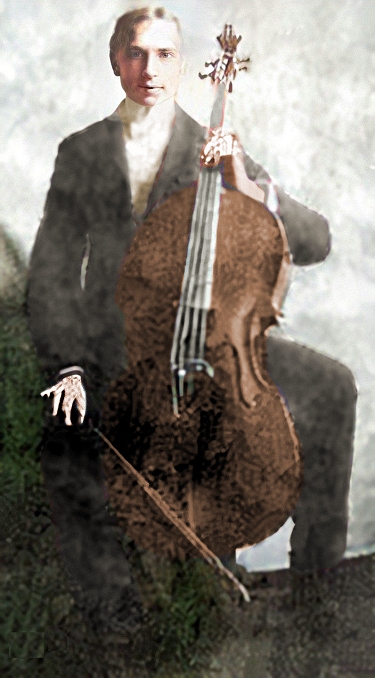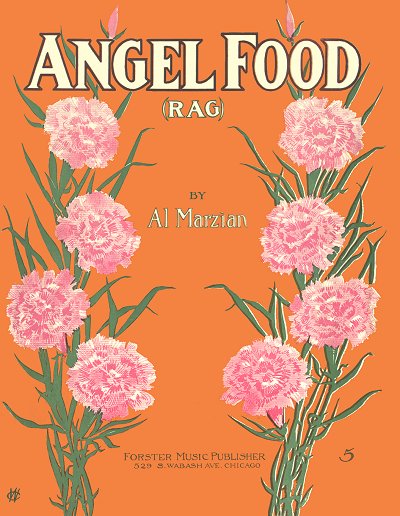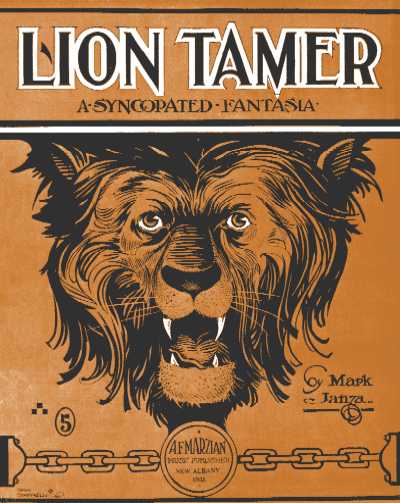 Albert Frederick Marzian (September 9, 1875 to June 29, 1947) | |
 Compositions Compositions | |
|
1897
Pansy March1898
DeMolay Commandery March1899
Elks Carnival March for Louisville1910
Aviation Rag [1]1911
Angel Food Rag1912
Youth and Beauty WaltzesEvening Chimes (Abendläuten) - Reverie |
1913
The Lion Tamer - A Syncopated Fantasy [1]Tonawanda - An Indian Characteristic 1914
Signal Bells - ReverieFlight of Fancy March Felecity - Hesitation Waltz Bale O' Cotton [1] 1915
The Message of the Evening Chimes [2]
1928
Charms [paraphrase of Believe Me if All Those Endearing Young Charms]
1. as Mark Janza
2. w/J. Clayton Ealy |
Albert Frederick Marzian was known to ragtime and music historians mostly as publisher Albert Marzian and the composer of one rag and a couple of other works for the longest time.
There is still only scant information available about his life, even from his helpful descendants. According to World War I draft records and his death certificate he was born in Wohynien, Russia, to German or Prussian parents August Friedrich Marzian and Caroline Wilhelmine Nuhst. Their ancestral location provides some confirmation concerning his most famous pen name, Mark Janza. The family immigrated to the United States in June of 1889 when Albert was still 13. Music evidently ran in his large family of as many as eleven siblings (most of whom died in childhood), as his younger brother by more than seven years, Alfred Rudolph Marzian (4/16/1882) was also a musician. Alfred is shown in the rare picture on the right at the cello. His involvement, if any, in Albert's publication business is still unclear.
 |
Both Marzian brothers were involved with the Louisville, Kentucky Symphony Orchestra, of which Albert was the conductor for some time. Albert also taught music at the high school level and conducted the Louisville orchestra. His second published piece from 1898, DeMolay Commandery March, was dedicated to Sir Knight William J. Watkins, featuring the coat badge of that branch of the Knights Templar of Louisville armory group on the cover. The second one from 1899 lists him as the conductor of the Columbia Orchestra in Louisville. Except for a time when he was known to possibly been working across the river from Louisville in New Albany, Indiana, in the mid-1910s (perhaps only on paper for publishing purposes), he spent most of his adult life in Jefferson County, Kentucky. Albert appeared there in the 1900 enumeration as a music teacher. Alfred, still living with his widowed mother, was working as a pressman in a printing office, possibly eventually facilitating the production of some of his older brother's publications. Albert was married to Myrtle Jacobson in 1900, after having been a boarder in her parent's large home where they continued to live for many years. Her presence in his life was something that at one time played into one of the mysteries of the Marzian family legacy.
The Marzians appear in 1910 census with Albert listed as a music director in the theater (likely arranger/conductor), living with Myrtle's parents. The core of his publications appeared over the next few years, with the challenging Lion Tamer: A Syncopated Fantasia and his Indian-themed intermezzo Tonawanda both published in New Albany, Indiana. From 1913 to the end of 1915, Albert ran a music store at the corner of Bank and East Market Streets in New Albany, selling sheet music, Starr pianos and player pianos, piano rolls, Starr phonographs, and records. Notices in New Albany papers in late December suggest a going out of business fire sale, and no further notices for the business were found from 1916 forward. Even though Marzian was registered for the draft for World War I in 1918, it appears unlikely that he ever served. In the 1920 enumeration Albert was listed as a high school music teacher, but still not as a naturalized citizen.
with the challenging Lion Tamer: A Syncopated Fantasia and his Indian-themed intermezzo Tonawanda both published in New Albany, Indiana. From 1913 to the end of 1915, Albert ran a music store at the corner of Bank and East Market Streets in New Albany, selling sheet music, Starr pianos and player pianos, piano rolls, Starr phonographs, and records. Notices in New Albany papers in late December suggest a going out of business fire sale, and no further notices for the business were found from 1916 forward. Even though Marzian was registered for the draft for World War I in 1918, it appears unlikely that he ever served. In the 1920 enumeration Albert was listed as a high school music teacher, but still not as a naturalized citizen.
 with the challenging Lion Tamer: A Syncopated Fantasia and his Indian-themed intermezzo Tonawanda both published in New Albany, Indiana. From 1913 to the end of 1915, Albert ran a music store at the corner of Bank and East Market Streets in New Albany, selling sheet music, Starr pianos and player pianos, piano rolls, Starr phonographs, and records. Notices in New Albany papers in late December suggest a going out of business fire sale, and no further notices for the business were found from 1916 forward. Even though Marzian was registered for the draft for World War I in 1918, it appears unlikely that he ever served. In the 1920 enumeration Albert was listed as a high school music teacher, but still not as a naturalized citizen.
with the challenging Lion Tamer: A Syncopated Fantasia and his Indian-themed intermezzo Tonawanda both published in New Albany, Indiana. From 1913 to the end of 1915, Albert ran a music store at the corner of Bank and East Market Streets in New Albany, selling sheet music, Starr pianos and player pianos, piano rolls, Starr phonographs, and records. Notices in New Albany papers in late December suggest a going out of business fire sale, and no further notices for the business were found from 1916 forward. Even though Marzian was registered for the draft for World War I in 1918, it appears unlikely that he ever served. In the 1920 enumeration Albert was listed as a high school music teacher, but still not as a naturalized citizen.Marzian may have performed on at least one piano roll, released in 1924 by QRS on their Concert Series, titled The Mill is in the Black Forest. There is a further possibility, although unconfirmed, that he may have recorded a few rolls for QRS under the name Silvio Marzini. As no other musician of that name existed in public records, and one of the pieces was Marzian's own Evening Chimes, it has not been ruled out as of yet. Albert gained new notoriety in 1926 when his band from Louisville Male High School won the class A prize in the first state school band contest. One late publication showed up in the late 1920s, but the bulk of his output was during the ragtime era. Albert appeared again in Louisville in the 1930 census, now a naturalized citizen. It appears that Albert and Myrtle did not have any children. Alfred had died during the 1920s, and his wife Martha was shown as widowed in 1930, with four sons, Alfred, Jr., Charles Albert, Richard and Theodore. Little mention was found of either Albert or Myrtle after 1930. He was listed in Louisville directories through at least 1939, shown as the director of the C-J and Louisville Times Band and a music teacher at the University of Louisville during most of the 1930s. Albert F. Marzian died in Louisville in 1947 at age 71, three years after Myrtle, who had passed on after 44 years of marriage to her husband.
Albert F. Marzian died in Louisville in 1947 at age 71, three years after Myrtle, who had passed on after 44 years of marriage to her husband.
 Albert F. Marzian died in Louisville in 1947 at age 71, three years after Myrtle, who had passed on after 44 years of marriage to her husband.
Albert F. Marzian died in Louisville in 1947 at age 71, three years after Myrtle, who had passed on after 44 years of marriage to her husband.One of the more recent discoveries made through evidence, forensic music examination, and educated conjecture by historians Dick Zimmerman and Bill Edwards [the author of this bio], was that the greatest composer in his sparse catalog, Mark Janza, was likely Marzian himself. This makes sense taking into account that he was a Russian/Germanic immigrant, where the family name reportedly may have gone back to their Russian heritage. It is there that the derivative root of Marzian (pronounced with a soft j - Mar-jeun) is sometimes Marjanza, either of which could be easily translated into Mar(k) Janza.
The significance of this name difference provides clues as to Marzian's stance as a publisher as well as composer. Owning a publishing firm in Louisville, Kentucky, with fellow composer E. Clinton Keithley, then later on his own in New Albany, Indiana, Marzian's own sparse compositions were cleverly written reveries, intermezzos, waltzes, marches, and one entry into the American Indian intermezzo category, in line with most of what was in his limited catalog. Curiously, he published his Angel Food Rag with Forster Music in Chicago, the only rag piece under his own name. The three Janza pieces were published by Albert himself (understandable given the recent findings), but with his identity otherwise obscured. They may have been rejected by Forster or others as being too complex or hard to market. Marzian may not want to have been directly associated with ragtime on his own marquis, in order to lend a more distinguished view of his "other" works. However, given the brilliance of both Aviation Rag and Lion Tamer, this view may have actually diminished his worth in retrospect. He also published one other rag by Louisville resident Charles A. Reccius, The Stop Rag, in 1913. While it was even speculated for some time that Mark Janza may have been a pseudonym for a female composer, perhaps even the aforementioned Mrs. Marzian, his family and additional research has refuted this as highly unlikely. She at no point was mentioned in official records or newspapers as a musician of any marked ability, as the composer of the Janza pieces would clearly have been.
While it was even speculated for some time that Mark Janza may have been a pseudonym for a female composer, perhaps even the aforementioned Mrs. Marzian, his family and additional research has refuted this as highly unlikely. She at no point was mentioned in official records or newspapers as a musician of any marked ability, as the composer of the Janza pieces would clearly have been.
 While it was even speculated for some time that Mark Janza may have been a pseudonym for a female composer, perhaps even the aforementioned Mrs. Marzian, his family and additional research has refuted this as highly unlikely. She at no point was mentioned in official records or newspapers as a musician of any marked ability, as the composer of the Janza pieces would clearly have been.
While it was even speculated for some time that Mark Janza may have been a pseudonym for a female composer, perhaps even the aforementioned Mrs. Marzian, his family and additional research has refuted this as highly unlikely. She at no point was mentioned in official records or newspapers as a musician of any marked ability, as the composer of the Janza pieces would clearly have been.In a paper on the rags that was researched and composed by Mr. Edwards, then subsequently endorsed in full by Mr. Zimmerman, the forensic evidence of certain unique harmonic patterns, structures, and individual runs were found as common threads between the Janza and Marzian compositions, thus linking them to a high degree of confidence. The same logic was applied to other composers, including Joplin, Lamb, Scott and Matthews in order to bolster the credibility of the specifics of this theory.
Among the creative elements that signify Marzian's work are the trios and interludes for Aviation Rag, Angel Food Rag, and Lion Tamer, which are all 32 bar sections with an exciting minor interlude. The descending pattern in Aviation Rag, reportedly written to coincide with Cal Rodgers long and ambitious flight across the U.S. which involved several crash landings (a flight that actually occurred the year following publication), could certainly indicate the descending of an airplane as it approaches the ground no matter the outcome. The trio in Lion Tamer, along with the interlude being one of the most brilliant passages in ragtime composition, certainly evokes the excitement of the circus along with the element of danger experienced when the tamer himself sticks his head in the lion's intimidating mouth. Even with his simple Evening Chimes, Marzian is able to create an atmosphere that musically visualizes a tangible experience.
I would like to add a personal note of thanks to both Janet Marzian Lee and her brother Alfred Marzian, who provided additional family information and background while we were able to provide them both some accounting of their uncle's important works and legacy. Also, researcher Reginald Pitts who uncovered a bit more of the heritage through official records. Finally, thanks to historian Ted Tjaden who found a couple of Marzian publications in hard-to-find catalogs. Finally, family member Jack Harmon who provided the c.1900 picture of a young Albert Marzian.
Anybody who is interested in the forensic analysis done by Mr. Edwards on the Marzian/Janza connection is invited to read the white paper on this in PDF Format - Revealing the Identity of Mark Janza.